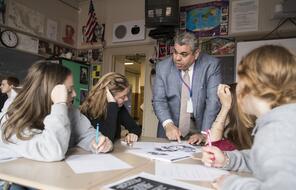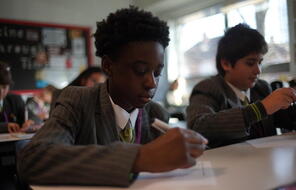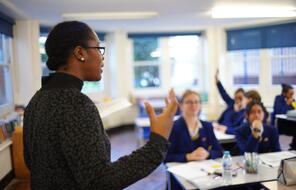As we prepare to return to school this year, knowing how to set the tone for an inclusive, productive classroom environment is essential. Since 1976, Facing History has offered industry-leading tools for establishing a classroom climate that deepens empathy, demands intellectual rigor, and invites a plurality of student voices. But something as seemingly basic as how we set up the physical space of our classrooms can also have a significant impact on classroom culture and learning outcomes.
Try these evidence-based classroom design strategies to promote student learning and connection in your classroom:
1. Optimize for Inclusion
As you create desk configurations and seating charts, keep inclusion top of mind. Design researchers argue that lecture-hall classroom configurations where students select their own seats “create tacit hierarchies in which the vocal and confident students sit forward” and receive more individual attention while quiet or timid students find seats in the back and avoid interaction.” Further, research shows that classroom configurations that increase student-faculty interaction improve academic outcomes. Consider this and your learning goals as you experiment with various classroom setups.
2. Promote Interaction
Learning spaces should be flexible enough to support both individual and group work. Consider arranging seating so that students can make eye contact with one another—this helps them really listen to what their classmates are saying and de-centers the teacher as the sole locus of instruction. At the same time, make sure to monitor how interaction-promoting classroom configurations (e.g. clusters of desks facing inward) may distract some students in certain learning contexts. Experiment to see what works for your students.
3. Decorate Deliberately
Consider displaying students’ work, visual markers of classroom norms, and/or posters that speak to students’ identities and chief concerns on the walls. But be aware that if you overdo the decorating, students may be overstimulated by the visual complexity. Researchers recommend keeping 20-50% of wall space clear for this reason and arranging seating so they face away from any visual distractions that cannot be removed.
4. Set the Tone with Color
Modulate the amount of color displayed in your classroom to drive positive academic and behavioral outcomes. Researchers recommend increasing colorful visual stimulation if your classroom has a “muted” color palette on the walls, and employing “calm[ing]” elements if the color palette of the classroom is already bright and stimulating.
5. Turn Down the Volume
Allowing silence can be a powerful and underused tool in the classroom for promoting deeper student reflection. Create more opportunities for such silence with these strategies:
- Placing rubber feet on movable furniture.
- Using rugs in high-traffic areas within the classroom.
- Using sound-absorbent materials to reduce echoes.
- Eliminating any objects that produce background noise.
6. Tap the Power of Nature
Researchers quantified the impacts of various classroom design strategies on learning outcomes and found that optimizing “naturalness”—or the extent to which a classroom environment simulates the outdoor environment—had the single greatest impact on learning outcomes. This finding is unsurprising given the wealth of resources pointing to the negative psychological impact of disconnection from nature across the lifespan (and particularly during childhood and adolescence).
Put these findings into practice by ensuring that you do not obstruct natural light sources, and using plants to offer students visual cues about their connection to a wider world beyond the walls of the classroom. Particular plants have also been shown to offer added benefits such as air filtration and, when situated on or outside of south-facing windows, can help to regulate classroom temperature.
Facing History & Ourselves invites educators to gear up for the first week of school with our Back-to-School Toolkit which includes our “Creating a Classroom Contract” lesson designed to build a climate of safety into your classroom norms.













